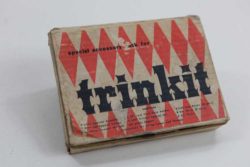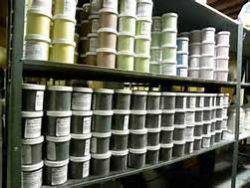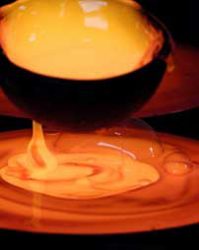Here is a conundrum: If vitreous enamels, and related tools and supplies, aren’t readily available, people can’t enamel. If people can’t enamel, suppliers can’t sell supplies. This chicken-and-egg problem is a huge obstacle for the growth of enameling in the U.S. and worldwide. How do people who use vitreous enamel deal with this conundrum? How does it shape enameling today, and how will it affect enameling’s future?
Share the Heat is pleased to announce a series of blogposts about tools and supplies for the enameling community. We will be examining the state of supply availability in interviews with several small independent U.S. suppliers, including Coral Shaffer of Enamelwork Supply, and Scott Ellis of e-namels.com. We will also be posting insider tips on how to find supply resources.
- Part 1 of this introduction will give a little background and recent history in order to put the tool/supply conundrum into perspective. It will focus on why supplies, especially enamel powders are not easy to find; why there is not much diversity in enamels that are available for sale; and why quality and customer service are sometimes problematic.
- Part 2 will be about industrial enameling supplies and tools specific to enameling, such as firing and application tools.
- Part 3 will focus on how the internet has changed availability and information about supplies and supply sources.
The Center for Enamel Art is committed to helping enamelists in their professional development. We believe strongly in the sharing of resources of all kind. We hope that this series of posts begins a much-needed discussion about one problem that has hindered the growth of enameling as a recognized art medium.
Where have all the manufacturers gone?

putting enamel in a ball mill
Before Thompson
First, let’s look at the evolution of enameling in the U.S. over the last hundred years. In the first half of the 20th century, there were several domestic manufacturers of what we call “jewelry” enamels. These companies, mostly small businesses run by a single person, produced enamel primarily for the watch and badge industries. Many of these small manufacturers went out of business early in the 20th century when the owners died. The loss of these businesses is especially acute when we consider the technical expertise that disappeared along with them. It is said that some of the owners even made special arrangements to be buried with little black books containing their coded enamel formulas, so that the formulas would not outlive them.

enameling kit
At the same time, enameling continued to grow in popularity. Throughout the 1940s and 1950s,”production enameling” of art and craft items increased, and the remaining enamel manufacturers sold enamel by the pound to artists and craftspeople, organizations, and schools. A growing number of “kitchen table enamelists” also discovered the medium through enameling kits that marketed enameling as a hobby.
In the 1960’s and 70’s, the popularity of enameling dwindled. Larger works fell out of style, and artists and craftspeople began making mostly small format jewelry. At the same time, the watch industry, which had used enamel to produce watch dials, reduced its use of vitreous enamel, and much of the badge industry moved to China. Some of the badge industry also began using so-called “soft” enamel (epoxy resin) instead of vitreous enamel.
The decrease in domestic product demand had an enormous effect on the enamel industry. For companies to stay in business, they had to sell their enamel for higher prices. Bill Helwig, who worked for Thompson Enamel, often noted that Thompson wasn’t selling enough product to justify lowering prices. People who had been buying 5-25 pounds of enamel at a time, he explained, were now buying two ounces, and a two-ounce jar could last a cloisonné artist years.

Carpenter and Wood catalogue cover from 1975
By the beginning of the 1960’s there was only one large jewelry enamel manufacturer in the U. S., Thompson Enamel, headquartered in Chicago, and two smaller companies, Carpenter & Wood, manufacturer of O’Brien Enamels, on the East Coast, and Amaco (American Art Clay Company) which sold mainly to hobbyists and which carried the enamels that were originally made by Woodrow Carpenter. Unable to adapt to the new climate or increasing regulation, Carpenter and Wood folded in the late 1970s. Its enamels are still known to some enamelists, and though rarely found, are highly prized.
Thompson Enamels: Last Man Standing

Thompson enamels
Thompson Enamel is the last enamel manufacturer in the U.S. It was purchased by the Ceramic Coating Company in 1980, which probably helped insure its survival.
Woodrow Carpenter, the owner of the Ceramic Coating Co. (no relation to the Carpenter of Carpenter and Wood), had a degree in ceramic engineering. He was bitten by the enamel bug quite early in his career and began creating enameled art and making his own lead bearing enamels. Sometime later, when he met Kenneth Bates, sometimes referred to as the father of American enameling, at an American Ceramics Society Conference he decided to concentrate solely on the making of enamels. As has been noted by Hal Nelson and Bernard Jazzar of the Enamel Arts Foundation, the popularity of enameling in the mid-20th century was tied to its association with ceramics. The two media share technology as well as supplies and some tools. Many of the bricks-and-mortar distributors of enamel were, and still are, ceramic suppliers.

Thompson smelter
According to Tom Ellis, editor of Glass on Metal and a longtime employee of Thompson, Carpenter rented space from a pottery studio in Cincinnati, OH, and continued making enamels, which initially he sold to Amaco. In 1960 Carpenter started the Ceramic Coating Company with Elmer Seibert, producing glass-lined pipes. The business expanded rapidly and moved across the river to Kentucky. Carpenter also established a line of lead-free jewelry enamels called Vitrearc.
After Thompson Enamel was purchased by Carpenter, it became a subdivision of the Ceramic Coating Co. but continued to operate in Chicago under the Thompson name until 1984 when Carpenter moved it to Kentucky. Thompson leaded enamels, so valued by enamelists around the world, were discontinued in 1994. Carpenter announced the phase-out in 1989. After 1994 only the lead free enamels were available.
When Carpenter discontinued the manufacture of leaded Thompson enamels, there was an uproar from those used to working with original Thompson enamels. Thompson hired Bill Helwig in 1976 to go on the road demonstrating the Vitrearc unleaded enamels. After a long hiatus from Thompson, Helwig was rehired by Thompson in 1994 just as the phase out of leaded enamels was completed. Until his death in 2012Helwig was a passionate spokesperson for Thompson product. In an attempt to pacify its customers, the company began purchasing Blythe leaded enamels from England to sell in the U.S., but soon stopped due to poor profits.
Today, enamelists wanting to buy “jewelry” enamels from a domestic manufacturer have only two options: buy directly from Thompson, or buy from Thompson distributors. Thompson essentially has a monopoly on the manufacture of domestic enamel.
Lead and Other Components
While lead gets most of the attention, it’s not the only reason the formulas of enamels have changed. Lead laws and their stringent enforcement have certainly affected the enamel industry, as well as glass and ceramic glaze industries in the U. S. and abroad. But other components were deemed health hazards as well, such as uranium oxide, cadmium and cobalt. Thompson’s Forsythia Yellow, for example, was discontinued due to its uranium oxide content, and now has an exorbitant resale value because of its scarcity.
The available palette of colors for glaze materials has had to change dramatically as governments pass stricter environmental regulations. Tom Ellis has noted that Thompson has had to re-formulate some colors because of raw materials changes. He has said that
due to some ceramic pigments becoming non-available, or being changed in their nature, or being mined in another part of the world, these changes can effect our end products. We do the best we can to re-formulate the enamel and try to come as close as possible to the older version. This is on-going. We have added new colors rather than eliminating colors.
. (It’s worth noting that these laws were passed to protect the manufacturers and the environment, not the users. Enamel itself, in its inert powder form, is not hazardous to use if basic precautionary measures are taken.)
Enamels Around the World

Pouring a Soyer enamel on steel slab to make an enamel cake
EU regulations have also affected European manufacturers. The number of enamel manufacturers in other countries has also dwindled in recent years. Schauer in Austria and Aoki (Kujaku) in Japan are the latest big manufacturers to disappear. Schauer, its formulas and enamels, was purchased by two companies, one in Germany and one in England. Principle manufacturers still in business worldwide are Soyer in France; Blythe, Milton Bridge, and Latham the UK; and Ninomiya in Japan.
Until a few years ago, enamels that were manufactured in other countries were also available in the U.S. through a few specific distributors, through phone or online sales. But imported enamel from abroad is getting more difficult to find. Companies like Bovano, which uses French Cristallerie St. Paul (Soyer) enamels, once sold its excess enamel powder to the public to lower its overhead, but no longer does this.
The two remaining distributors are Enamelwork Supply in Seattle, owned by Coral Shaffer, and Schlaifer’s Enameling Supplies in Nevada, which is run by Vicki Mathieu after the death of Joan Schlaifer. Enamelwork Supply distributes Ninomiya enamels, and Schlaifer distributes Cristallerie St. Paul enamel (Soyer) from Bovano and Thompson enamels to resale. These are both small, one-person operations, managed by experienced enamelists who are passionate about enameling and share their expertise with their customers.
Distribution of Thompson Enamel is a different story. The chief distributor of Thompson enamels today is Rio Grande. A quick glance of the list of distributors on the Thompson Enamel website reveals something interesting: there aren’t very many. There are very few bricks and mortar distributors, and most of those are ceramic suppliers or, in the case of C&R Loo, glass suppliers (because Thompson also manufactures a line of glass powders suitable for fused glass application). There is not a single retail outlet in the U.S. where someone can walk in and buy a complete selection of enameling tools and supplies from various manufacturers.
Product, distributors, and knowledge: these are essential to the survival and growth of enameling. We’ve taken a look at the state of art enamel supply in the U.S. and worldwide. Next, we’ll consider industrial supplies and tools. Stay tuned!

Wonderful article, thank you so much
Hi! What an interesting read! We are a company called W.G Ball based in the U.K that manufacturer a wide range of Transparent and Opaque leadfree Jewelry enamels as well a variety of enamelling accessories. We are looking at increasing our exposure in the U.S and will be attending the Enamelist Society Conference in Gatliburg this year to learn more about the American marketplace. You can order our products directly from our website (which has just been improved for overseas customers) or through our U.S distributors e-namels.com and Allcraft. Take a look at our website….
http://www.wgball.co.uk
P.S The picture in the article of the red enamel being loaded onto a ball mill was taken at our factory a couple of months ago!
Thanks
W.G Ball
[…] with hard-to-find enamels, tools, and expert advice. In this illuminating interview, part of our Tools and Supplies series, she speaks at length about the pleasures and challenges of selling enamels, and why Japanese […]